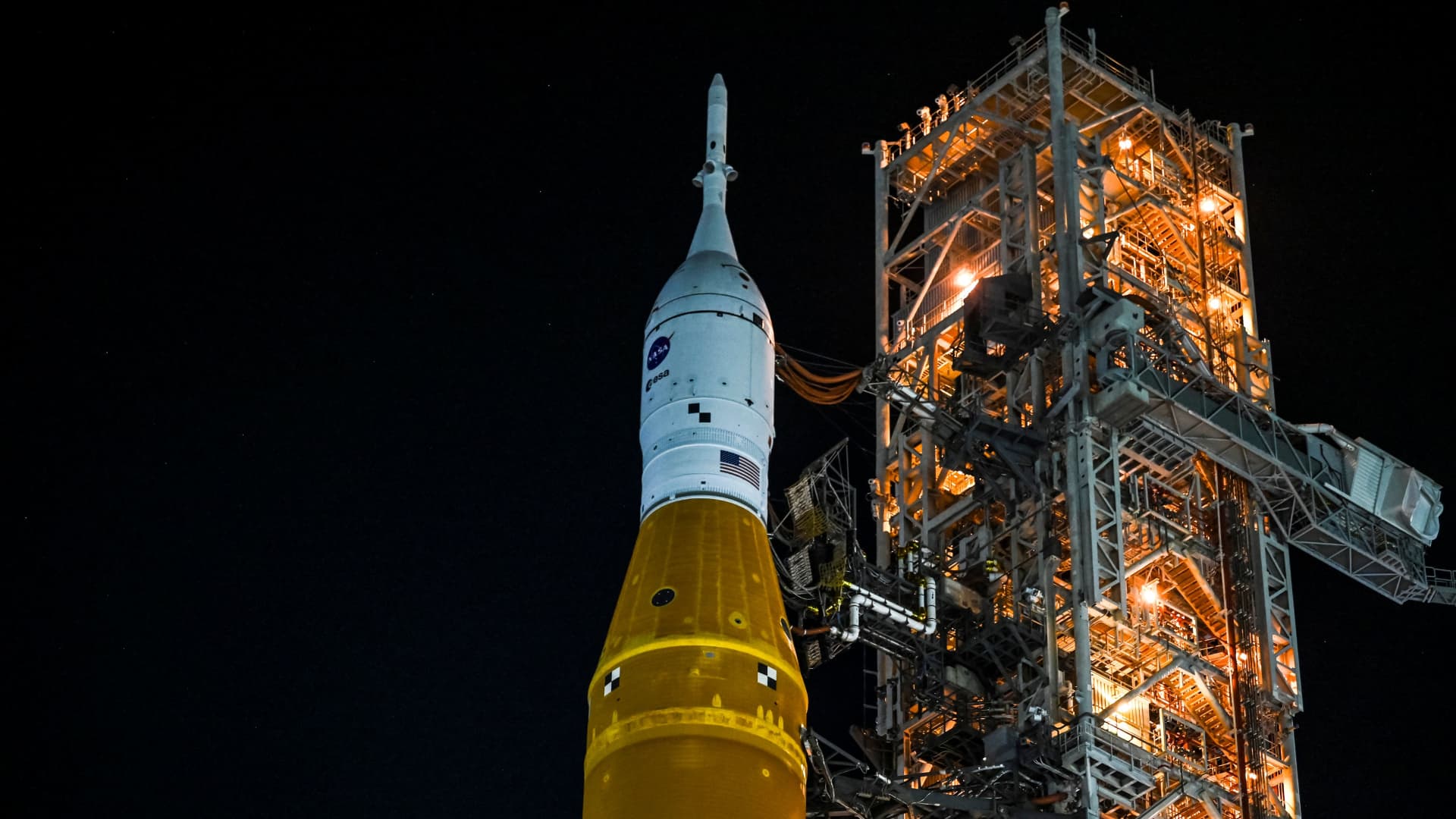Products You May Like
NASA plans to launch the Artemis I mission on Monday from Kennedy Space Center in Florida, sending the Space Launch System (SLS) rocket and Orion capsule on a more than month-long journey around the moon. —
The uncrewed launch marks the debut of the most powerful rocket ever assembled and kicks off NASA’s long-awaited return to the moon’s surface. It’s the first mission in NASA’s Artemis lunar program, which is expected to land the agency’s astronauts on the moon by its third mission in 2025.
While Artemis I will not carry astronauts, nor land on the moon, the mission is critical to demonstrating that NASA’s monster rocket and deep space capsule can deliver on their promised abilities. Artemis I has been delayed for years, with the program running billions over budget.
The Artemis I mission represents a crucial turning point in NASA’s moon plans.
Despite the delays, and absorbing much of NASA’s relatively small budget by federal agency standards, the Artemis program has enjoyed strong bipartisan political support.
Officials in 2012 estimated that the SLS rocket would cost $6 billion to develop, debut in 2017 and carry a $500 million per launch price tag. But the rocket is only just now debuting, having cost more than $20 billion to develop, and its per launch price tag has ballooned to $4.1 billion.
NASA’s Inspector General, its internal auditor, earlier this year said Artemis is not the “sustainable” moon program that the agency’s officials say it is. The watchdog found more than $40 billion has already been spent on the program, and projected NASA would spend $93 billion on the effort through 2025 – when the first landing is planned.
But even that 2025 date is in doubt, according to NASA’s Inspector General, which said that development technologies needed to land on the moon’s surface are unlikely to be ready before 2026, at the earliest.
NASA’s Artemis plan relies on the success of another monster rocket as well: SpaceX’s Starship. The agency last year awarded SpaceX with a $2.9 billion contract to develop a moon-specific version of the rocket to serve as the crew lunar lander for the Artemis III mission.
SpaceX began testing of its Starship spacecraft in earnest in 2019, but that rocket has yet to reach orbit.
A host of aerospace contractors across the U.S. support the hardware, infrastructure and software for NASA’s Artemis I – Boeing, Lockheed Martin, Northrop Grumman, Aerojet Rocketdyne and Jacobs lead the effort. According to NASA, the Artemis program supports about 70,000 jobs around the country.
Multiple NASA centers are involved as well, beyond Kennedy as the launch site – including the DC headquarters, Marshall in Alabama, Stennis in Mississippi, Ames in California, and Langley in Virginia.
In the event that technical issues or weather delay the Aug. 29 launch attempt, NASA has back-up launch dates scheduled for Sept. 2 and Sept 5.
Here’s what you should know about the launch:
The rocket: SLS
Standing as high as a skyscraper at 322 feet tall, the SLS rocket is a complex vehicle built on technologies used and improved on from NASA’s Space Shuttle and Apollo programs.
Fully fueled, SLS weighs 5.7 million pounds, and produces up to 8.8 million pounds of thrust – 15% more than the Saturn V rockets last century. SLS uses four liquid-fueled RS-25 engines, which flew on the Space Shuttle before being refurbished and upgraded, as well as a pair of solid rocket boosters.
SLS’s core stage gets its orange color from the thermal protection system that covers it, which is a spray-on foam insulation. For the first three Artemis missions, NASA is using a variation of SLS known as Block 1. For later missions, NASA plans to roll out an even more powerful variation, known as Block 1B.
The capsule: Orion
NASA’s Orion capsule can carry four astronauts on missions up to 21 days long without docking with another spacecraft. At its core is the crew module, which is designed to endure the harsh conditions of flying into deep space.
After launch, Orion is fueled and propelled by the European Service Module, which was built by the European Space Agency and contractor Airbus.
For Artemis I, there will be three mannequins inside the Orion capsule to collect data via sensors about what astronauts will experience on the trip to-and-from the moon. The return to Earth will be especially crucial, as Orion will re-enter the Earth’s atmosphere at about 25,000 miles per hour. A heat shield protects the exterior of Orion, and a set of parachutes will slow it down for a splash landing in the ocean
The mission around the moon
Artemis I will travel about 1.3 million miles over the course of 42 days, spanning several phases. After separating from SLS, the capsule will deploy solar arrays and begin a multi-day journey to the moon – departing from Earth’s orbit in what is known as a “trans-lunar injection.”
NASA plans to fly Orion as close as 60 miles above the moon’s surface, before moving into a wide orbit around the lunar body. To return, Orion will use the moon’s gravity to assist it in setting a trajectory back into Earth’s orbit.
Orion is expected to splash down in the Pacific Ocean – off the coast of San Diego, California – where a team of NASA and Department of Defense personnel will recover the capsule.
In addition to the mannequins onboard Orion, Artemis I carries several payloads such as cube satellites, technology demonstrations and science investigations.
